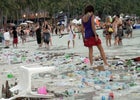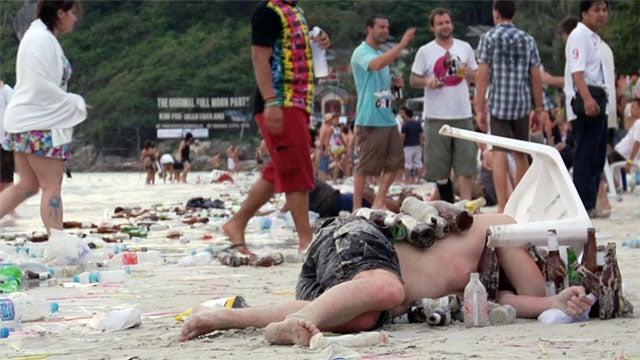We’d all like to hew to the practice of leaving only footprints in the places we travel, and we all know that’s as untenable as the notion of a true paradise. Now there’s a film that shows a slice of the marks – physical, cultural and ecological – we leave behind, and it does so in stark detail.
 Trash washed up on Haadrin Beach, Koh Pha Ngan island, Thailand.
Trash washed up on Haadrin Beach, Koh Pha Ngan island, Thailand.The film, , is Pegi Vail’s first feature-length film but it was decades in the making. An anthropologist and associate director at the Center for Media, Culture, and History at New York University, Vail collected footage during her many trips around the world and sifted through that as well as archival footage from various sources to convey the transformations that tourists have made in Bolivia, Thailand, and Africa. She tells the stories that comprise Gringo Trails through the voices of travelers, travel writers (including Pico Iyer) the guides and hosts who aspire to both profit from and protect their enchanting homelands.
Whether you’re an armchair traveler or you’re working through a bucket list of exotic destinations, it’s an important and moving film. It premiered in New York City on October 19, at the American Museum of Natural History’s Margaret Mead Film Festival. Its next showing is November 23, during the Canadian film festival. is distributing the film in North America.
One of the most striking themes woven through Gringo Trails is that the places that have been overrun by tourists, like Thailand’s Koh Pha Ngan and its Haad Rin beach, were “discovered” not by multi-national hospitality prospectors but by curious and adventurous backpackers. (The Gringo Trail is a moniker for South American destinations that white travelers have put on the map.) Word gets out, and other travelers arrive. It has always been this way, but in the age of guidebooks and then, of course, the Internet, the speed and scope of discovery is amplified.
I asked Vail, who first visited Haad Rin in 1986 when it was becoming popular among backpackers but before it had really exploded as a party scene, whether there are still places that remain in relative obscurity. “I think there are,” she says, adding that the people who are finding those places are not following guide books or online forums. “We’re not hearing about those places.”
Eventually, of course, we will.
“It’s a fine line I’m walking, as a guidebook author,” Anja Mutic, who writes for Lonely Planet, says in the film. “It is a huge responsibility, especially in places like Bolivia, where tourism can really make it or break it. How do you encourage sustainable development and make travel accessible?” Part of that responsibility falls on local governments, she says.
Many organizations around the world, including the (CREST) and the , have spent many years pushing for international tourism standards and best practices designed to prevent the cultural and environmental degradation that often comes in the wake of tourism booms.
“People think of it just as the leisure industry, but tourism is very powerful,” says Vail. In 2011, international tourism receipts exceeded $1 trillion for the first time, according to the World Tourism Organization.
Vail sees parallels between tourism globalization and urban gentrification. She made her home in Brooklyn’s Williamsburg neighborhood many years before it evolved into the epicenter of East Coast hipsterdom. “I can’t turn it back,” she says of her hood. But planning is important, both in cities and in booming tourist destinations, she says. When exotic locations are in the midst of being loved to death, “there is a certain stage, halfway through, when we can make choices before it gets to those later stages.”
Despite its sad and cringe-inducing vignettes – like hordes of tourists in thrashing Haad Rin beach or stalking snakes in Bolivia – Gringo Trails is ultimately hopeful. It opens with the story of Israeli adventurer Yossi Ghinsberg’s month-long marooning and then rescue in the Bolivian jungle, which paradoxically drew thousands of travelers to Rurrenabaque where they sought out similar adventures that ultimately turned into Disneyland-esque boat tours of the Tuichi River. But the film ends on a hopeful tone, showing how that crush of tourism can be converted into a sustainable model, as at the Chalalan Ecolodge in Bolivia’s Madidi National Park.


